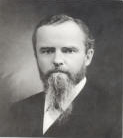Millard, a suburban area in southwest Omaha, was named for Ezra Millard (1833-1886). The Millards came to North America in the early 1700s. Isaiah K., a third generation of Millards in America, married Elizabeth Hopkins, a daughter of the Rhode Island governor. They moved to Hamilton, Canada in the 1830s where Ezra and Joseph were born. The family moved to Iowa in 1850. Ezra married Anna Clark Williams, niece of Willard Barrows, a wealthy man from Davenport, Iowa. Ezra, Joseph and Willard formed a land company and crossed the prairie in a covered wagon to arrive in Omaha in the summer of 1856. In 1870, Ezra platted Millard, a mostly uninhabited prairie 12 miles southwest of the city. He also left a legacy by establishing the Omaha National Bank, Omaha Library Association, Omaha School for the Deaf, and Omaha's first public high school. He served as the twelfth mayor of Omaha and was a member of the Territorial Legislature. In 1988, Ezra Millard Elementary School was built and named in his honor. Millard's first owner was Seth Billington, a sergeant in the Massachusetts militia during the war with the British. In recognition of his faithful service, Billington received land west of Omaha under the 1855 Bounty Act. No evidence exists that he ever came to the area. According to the “History Of Nebraska” published in 1882, the first settlers in Millard were the Stevens family. In 1855, George Stevens, his wife Mary and brother Cyrus acquired the 320 acres although it isn't recorded how they took the title. In September of 1856, Dr. Harvey Link of New Albany, Indiana purchased 320 acres for $300 near present-day 144th and F Streets. Dr. Link was a descendent of an old southern family from Virginia. He was a pioneer, physician and surgeon, member of the Nebraska territorial legislature and president of the Nebraska State Medical Association. The timing of Millard’s first settlers was brutal as “the winter of 1956-57 was one of unparalleled severity.” They reported 60-foot snow drifts and weather so cold the mercury in their thermometers froze. In the spring of 1856, Peter Glandt and his family homesteaded 2.5 miles north of Dr. Link. Two years later, Halsey Hall, John Hollenback, German Adsit and Henry Kursten settled in the area. Others were attracted after President Abraham Lincoln signed the Homestead Act of 1862, allowing people to claim 160 acres of undeveloped federal land by building a home and cultivating the ground. Millard first settlers arrived after making a difficult journey by horse and buggy. The town’s future was secured when the original route of the Transcontinental Railroad came right through what was to become the main business area of Millard. Union Pacific initiated mainline service in 1865, two years before Nebraska was granted statehood and three years after Abraham Lincoln signed the Pacific Railway Act. In a history of Nebraska published in 1882, Millard is described as: "A station on the Union Pacific road, twenty-one miles from Omaha by rail, but eleven miles as the swallows fly." In 1908, the Lane Cutoff created an 11.6 mile short-cut connecting Omaha and Millard. Fifty years later, the location of Interstate 80 was influenced by the Cutoff. Access to transportation was the key to Millard's development. In 1871, George Stevens sold the town to E.A. Perley, who sold it the same year to Ezra Millard. Millard began bringing in businesses in 1872. When the town was platted in 1873, the streets were laid out parallel to the railroad tracks as they angled through the area in contrast to the east-west orientation of most towns. Today, most of the tracks have been removed so the slanting streets appear arbitrary -- an unexplained oddity. The access to the railroad was the key to the town's survival during a time when many other small towns failed.Most buildings at the time were constructed with wood, and in 1883 William von Dohren founded the lumber company that would become Millard Lumber Inc. The first house built in town was that of farmer Henry Kelsey, who later served as a Justice of the Peace. The first village board met on Sept. 26, 1885, and Millard, Nebraska was officially incorporated. The first board of trustees included Christ Kaelber, John Lempke, Charles Stetzner, Henry Lomans and Julius Schroeder. The first official population count was 328 in 1890, and an ordinance established Millard as a self-supporting community with a church, bank, two grain elevators, three hotels, two blacksmith shops, one wagon shop, a brick factory, lumber yard, cigar factory, two saloons and several other businesses.Even before there was a town of Millard, records show the first school was established in 1868 with George Potwin as teacher and six pupils. They met in various buildings on Dr. Harvey Link's farm (near present-day 144th and F Streets). In 1876, a one-room school was built and furnished for $2,700. It was located opposite of the train depot. One teacher taught 30 students. The school board was composed of Christian Kaelber, a grain and lumber dealer, Samuel Cottner, owner of grain elevators, and Dr. Harvey Link, the town's first doctor.In 1884, a new two-story school with a cupola was erected at what is now 132nd and Millard Avenue. The school consisted of grades one through ten. The Millard Courier newspaper listed the faculty for the 1914-15 school year as Miss Cronk, Miss Paine, Miss Softley and T.C. Grogan who taught the upper grades and served as principal.




